From Wikipedia, the free encyclopedia
| B-1 Lancer | |
|---|---|
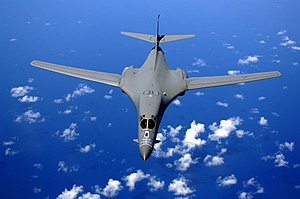 |
|
| A B-1B flying over the Pacific Ocean. | |
| Role | Supersonic Strategic bomber |
| National origin | United States |
| Manufacturer | North American Rockwell/Rockwell International Boeing |
| First flight | 23 December 1974 |
| Introduction | 1 October 1986 |
| Status | In service |
| Primary user | United States Air Force |
| Produced | 1973–74, 1983–88 |
| Number built | B-1A: 4 B-1B: 100 |
| Unit cost | |
Designed by Rockwell International, the bomber's development was delayed multiple times over its history, as the theory of strategic balance changed from flexible response to massive retaliation and back again. Each change in stance changed the perceived need for manned bombers. The initial B-1A version was developed in the early 1970s, but its production was canceled, and only four prototypes were built. The need for a new platform once again surfaced in the early 1980s, and the aircraft resurfaced as the B-1B version with the focus on low-level penetration bombing. However, by this point development of stealth technology was promising an aircraft of dramatically improved capability. Production went ahead as the B version would be operational before the "Advanced Technology Bomber" (which became the B-2 Spirit), during a period when the B-52 would be increasingly vulnerable. The B-1B entered service in 1986 with the USAF Strategic Air Command (SAC) as a nuclear bomber.
In the early 1990s, following the Gulf War and concurrent with the disestablishment of SAC and its reassignment to the newly formed Air Combat Command (ACC), the B-1B was converted to conventional bombing use. It first served in combat during Operation Desert Fox in 1998 and again during the NATO action in Kosovo the following year. The B-1B has supported U.S. and NATO military forces in Afghanistan and Iraq. The Lancer is the supersonic component of the USAF's long-range bomber force, along with the subsonic B-52 and Northrop Grumman B-2 Spirit. The bomber is commonly called the "Bone" (originally from "B-One"). With the retirement of the General Dynamics/Grumman EF-111A Raven in 1998 and the Grumman F-14 Tomcat in 2006, the B-1B is the U.S. military's only active variable-sweep wing aircraft. The B-1B is expected to continue to serve into the 2030s, with the Next-Generation Bomber to start supplementing the B-1B in the 2020s.
Development
Background
Main article: North American XB-70 Valkyrie
The U.S. Air Force in 1955 issued requirements for a new bomber with the payload and range of the Boeing B-52 Stratofortress and the Mach 2 maximum speed of the Convair B-58 Hustler.[2] In December 1957, the U.S. Air Force selected North American Aviation's proposal to replace the B-52 with the B-70 Valkyrie.[3] The Valkyrie was a six-engine bomber that could reach Mach 3 speeds at high altitude (70,000 ft or 21,000 m)[4] to avoid interceptor aircraft, the only effective anti-bomber weapon in the 1950s.[5] Soviet aircraft were already unable to intercept the high-flying Lockheed U-2;[6] the Valkyrie would fly at similar altitudes but much higher speeds.[5] In combat, the B-70 was expected to simply fly right by the defenders.By the late 1950s, however, anti-aircraft surface-to-air missiles (SAMs) could threaten high-altitude aircraft,[7] as demonstrated by the 1960 downing of Gary Powers's U-2.[8] The USAF Strategic Air Command (SAC) began moving its bombers to low-level penetration before the U-2 downing. This tactic greatly reduces radar detection distances by use of terrain masking; using features of the terrain like hills and valleys, the line-of-sight from the radar to the bomber can be broken, rendering the radar (and human observers) incapable of seeing the target.[9] Even at somewhat higher altitudes, radar systems of the era were subject to "clutter" from stray returns from the ground and other objects, requiring a minimum angle above the ground to be effective. Bombers flying at low altitudes could remain under these angles simply by flying around the radar sites. This combination of effects made SAMs of the era ineffective against low-flying aircraft.[9][10] The same effects also meant that low flying aircraft were difficult to detect by higher flying interceptors, since their radar systems could not readily pick out opposing aircraft against the clutter from ground reflections.
Planners outlined a series of low-level profiles for the B-70, but higher drag at low level limited the B-70 to subsonic speed while dramatically decreasing its range.[7] The result would be an aircraft with somewhat higher subsonic speed, but less range than the B-52 it was meant to replace. Unsuited for the new low-altitude role, and because of a growing shift to the intercontinental ballistic missile (ICBM) force, the B-70 bomber program was canceled in 1961 by President John F. Kennedy,[5][11] and the two XB-70 prototypes were used in a supersonic research program.[12]
Although never intended for the low-level role, the B-52's flexibility allowed it to outlast its intended successor as the nature of the air war environment changed. The B-52's huge fuel load allowed it to operate at lower altitudes for longer times, and the large airframe allowed the addition of improved electronic countermeasures suites to deal with radars.[13] During the Vietnam War the concept that all future wars would be nuclear was turned on its head, and the "big belly" modifications increased the B-52's total bomb load to 60,000 pounds (27,000 kg),[14] turning it into a powerful tactical aircraft which could be used against ground troops along with strategic targets from high altitudes.[10] The much smaller bomb bay of the B-70 would have made it much less useful in this role.
Although effective, the B-52 was not ideal for the low-level role. This led to a number of aircraft designs known as "penetrators", which were tuned specifically for long-range low-altitude flight. The first of these designs to see operation was the supersonic F-111 fighter-bomber, which used variable-sweep wings for tactical missions.[15] Similar aircraft also emerged for other users as well, notably the TSR-2, and later, Panavia Tornado and Sukhoi Su-24. A number of studies on a strategic-range counterpart followed.
Design studies and delays
The first post-B-70 strategic penetrator study was known as the Subsonic Low Altitude Bomber (SLAB), which was completed in 1961. This produced a design that looked more like an airliner than a bomber, with a large swept wing, T-tail and large high-bypass engines.[16] This was followed by the similar Extended Range Strike Aircraft (ERSA), which added a variable-sweep wing planform, something in vogue in the aviation industry. ERSA envisioned a relatively small aircraft with a 10,000 pounds (4,500 kg) payload and a range of 8,750 nautical miles (16,200 kilometres), with 2,500 nmi (4,600 km) being flown at low altitudes. In August 1963 the similar Low-Altitude Manned Penetrator (LAMP) design was completed, which called for an aircraft with a 20,000 pounds (9,100 kg) bomb load and somewhat shorter range of 7,150 nmi (13,240 km).[17][18]These all culminated in the October 1963 Advanced Manned Precision Strike System (AMPSS), which led to industry studies at Boeing, General Dynamics, and North American.[19][20] In mid-1964, the USAF had revised its requirements and retitled the project as Advanced Manned Strategic Aircraft (AMSA), which differed from AMPSS primarily in that it also demanded a high-speed high-altitude capability, similar to that of the existing Mach 2 class B-58 Hustler.[21] Given the lengthy series of design studies, Rockwell engineers joked that the new name actually stood for "America's Most Studied Aircraft".[22][23]
The arguments that led to the cancellation of the B-70 program had led some to question the need for a new strategic bomber of any sort. The air force was adamant about retaining bombers as part of the nuclear triad concept that included bombers, ICBMs, and submarine-launched ballistic missiles (SLBMs) in a combined package that complicated any potential defense. They argued that the bomber was needed to attack hardened military targets and to provide a safe counterforce option because the bombers could be quickly launched into safe loitering areas where they could not be attacked. However, the introduction of the SLBM mooted the mobility and survivability argument, and a newer generation of ICBMs had the accuracy and speed needed to attack point targets. During this time, ICBMs were seen as a less costly option based on their lower unit cost,[24] but development costs were much higher.[7] Secretary of Defense Robert McNamara preferred ICBMs over bombers for the Air Force portion of the deterrent force[25] and felt a new expensive bomber was not needed.[26][27] McNamara limited the AMSA program to studies and component development beginning in 1964.[27]
Program studies continued; IBM and Autonetics were awarded AMSA advanced avionics study contracts in 1968.[27][28] McNamara remained opposed to the program in favor of upgrading the existing B-52 fleet and adding nearly 300 FB-111s for shorter range roles then being filled by the B-58.[10][27] He again vetoed funding for AMSA aircraft development in 1968.[28]
B-1A program
President Richard Nixon reestablished the AMSA program after taking office, keeping with his administration's flexible response strategy that required a broad range of options short of general nuclear war.[29] Nixon's Secretary of Defense, Melvin Laird, reviewed the programs and decided to lower the numbers of FB-111s, since they lacked the desired range, and recommended that the AMSA design studies be accelerated.[29] In April 1969, the program officially became the B-1A.[10][29] This was the first entry in the new bomber designation series, first created in 1962. The Air Force issued a request for proposals in November 1969.[30]Rockwell's design featured a number of features common to 1960s U.S. designs. Among these was the use of a "crew capsule" that ejected as a unit during emergencies, which was introduced to improve survivability in the case of an ejection at high speed. Additionally, the design featured large variable-sweep wings in order to provide both high lift during takeoff and landing, and low drag during a high-speed dash phase.[35] With the wings set to their widest position the aircraft had considerably better lift and power than the B-52, allowing it to operate from a much wider variety of bases. Penetration of the USSR's defences would take place at supersonic speed, crossing them as quickly as possible before entering into the less defended "heartland" where speeds could be reduced again.[35] The large size and fuel capacity of the design would allow the "dash" portion of the flight to be relatively long.
In order to achieve the required Mach 2 performance at high altitudes, the exhaust nozzles and air intake inlets were variable.[36] Initially, it had been expected that a Mach 1.2 performance could be achieved at low altitude, which required that titanium be used in critical areas in the fuselage and wing structure. The low altitude performance requirement was later lowered to Mach 0.85, reducing the amount of titanium and therefore cost.[32] A pair of small vanes mounted near the nose are part of an active vibration damping system that smooths out the otherwise bumpy low-altitude ride.[37] The first three B-1As featured an escape capsule that ejected the cockpit with all four crew members inside. The fourth B-1A was equipped with a conventional ejection seat for each crew member.[38]
The B-1A mockup review occurred in late October 1971.[39] The first B-1A prototype (serial no. 74-0158) flew on 23 December 1974. Three more B-1A prototypes followed.[40] As the program continued the per-unit cost continued to rise in part because of high inflation during that period. In 1970, the estimated unit cost was $40 million, and by 1975, this figure had climbed to $70 million.[41]
New problems and cancellation
In 1976, Soviet pilot Viktor Belenko defected to Japan with his MiG-25 "Foxbat".[42] During debriefing he described a new "super-Foxbat" (almost certainly referring to the MiG-31) that had look-down/shoot-down radar systems in order to attack cruise missiles. This would also make any low-level penetration aircraft "visible" and easy to attack.[43] Given that the B-1's armament suite was similar to the B-52, and it now appeared no more likely to survive Soviet airspace than the B-52, the program was increasingly questioned.[44] In particular, Senator William Proxmire continually derided it in public, arguing it was an outlandishly expensive dinosaur. During the 1976 federal election campaign, Jimmy Carter made it one of the Democratic Party's platforms, saying "The B-1 bomber is an example of a proposed system which should not be funded and would be wasteful of taxpayers' dollars."[45]When Carter took office in 1977 he ordered a review of the entire program. By this point the projected cost of the program had risen to over $100 million per aircraft, although this was lifetime cost over 20 years. He was informed of the relatively new work on stealth aircraft that had started in 1975, and he decided that this was a better avenue of approach than the B-1. Pentagon officials also stated that the AGM-86 Air Launched Cruise Missile (ALCM) launched from the existing B-52 fleet would give the USAF equal capability of penetrating Soviet airspace. With a range of 1,500 miles (2,400 km), the ALCM could be launched well outside the range of any Soviet defenses and penetrate at low altitude just like a bomber, but in much greater numbers at a lower cost.[46] A small number of B-52s could launch hundreds of ALCMs, saturating the defense. A program to improve the B-52 and develop and deploy the ALCM would cost perhaps 20% of the price to deploy the planned 244 B-1As.[45]
On 30 June 1977, Carter announced that the B-1A would be canceled in favor of ICBMs, SLBMs, and a fleet of modernized B-52s armed with ALCMs.[34] Carter called it "one of the most difficult decisions that I've made since I've been in office." No mention of the stealth work was made public with the program being top secret, but today it is known that in early 1978 he authorized the Advanced Technology Bomber (ATB) project, which eventually led to the B-2 Spirit.[47]
Domestically, the reaction to the cancellation was split along partisan lines. The Department of Defense was surprised by the announcement; internal expectations were that the number of B-1s ordered would be reduced to around 150.[48] Congressman Robert Dornan (R-CA) claimed, "They're breaking out the vodka and caviar in Moscow."[49] In contrast, it appears the Soviets were more concerned by large numbers of ALCMs representing a much greater threat than a smaller number of B-1s. Soviet news agency TASS commented that "the implementation of these militaristic plans has seriously complicated efforts for the limitation of the strategic arms race."[45] Western military leaders were generally happy with the decision. NATO commander Alexander Haig described the ALCM as an "attractive alternative" to the B-1. French General Georges Buis stated "The B-1 is a formidable weapon, but not terribly useful. For the price of one bomber, you can have 200 cruise missiles."[45]
Flight tests of the four B-1A prototypes for the B-1A program continued through April 1981. The program included 70 flights totaling 378 hours. A top speed of Mach 2.22 was reached by the second B-1A. Engine testing also continued during this time with the YF101 engines totaling almost 7,600 hours.[50]
Shifting priorities
It was during this period that the Soviets started to assert themselves in several new theaters of action, in particular through Cuba during the Angolan Civil War starting in 1975 and the Soviet invasion of Afghanistan in 1979. U.S. strategy to this point had been focused on containing Communism and preparation for war in Europe. The new Soviet actions revealed that the military lacked capability outside these narrow confines.[51]The U.S. Army responded by accelerating its Rapid Deployment Forces concept but suffered from major problems with airlift and sealift capability.[52] In order to slow an enemy invasion of other countries, air power was critical; however the key Iran-Afghanistan border was outside the range of the U.S. Navy's carrier-based attack aircraft, leaving this role to the air force. Although the B-52 had the range to support on-demand global missions, its long runway requirements limited the forward basing possibilities.[53]
During the 1980 presidential campaign, Ronald Reagan campaigned heavily on the platform that Carter was weak on defense, citing the cancellation of the B-1 program as an example, a theme he continued using into the 1980s.[54] During this time Carter's defense secretary, Harold Brown, announced the stealth bomber project, apparently implying that this was the reason for the B-1 cancellation.[55]
B-1B program
On taking office, Reagan was faced with the same decision as Carter before: whether to continue with the B-1 for the short term, or to wait for the development of the ATB, a much more advanced aircraft. Studies suggested that the existing B-52 fleet with ALCM would remain a credible threat until 1985, as it was predicted that 75% of the B-52 force would survive to attack its targets.[56] After this, the introduction of the SA-10 missile, the MiG-31 interceptor and the first Soviet Airborne Early Warning and Control (AWACS) systems would make the B-52 increasingly vulnerable.[57] During 1981, funds were allocated to a new study for a bomber for the 1990s time-frame, this led to the Long-Range Combat Aircraft (LRCA) project. The LRCA evaluated the B-1, F-111 and ATB as possible solutions; an emphasis was placed on multi-role capabilities, as opposed to purely strategic operations.[56]In January 1982 the U.S. Air Force awarded two contracts to Rockwell worth a combined $2.2 billion for the development and production of 100 new B-1 bombers.[59] Numerous changes were made to the design to make it better suited to the now expected missions, resulting in the new B-1B.[46] These changes included a reduction in maximum speed,[55] which allowed the variable-aspect intake ramps to be replaced by simpler fixed geometry intake ramps in the newer design. This reduced the B version's radar signature; the reduction in radar cross-section was seen as a good trade off for the speed decrease.[35] High subsonic speeds at low altitude became a focus area for the revised design,[55] and low-level speeds were increased from about Mach 0.85 to 0.92. The B-1B has a maximum speed of Mach 1.25 at higher altitudes.[35][60]
The B-1B's maximum takeoff weight was increased to 477,000 pounds (216,000 kg) from the B-1A's 395,000 pounds (179,000 kg).[35][61] The weight increase was to allow for takeoff with a full internal fuel load and for external weapons to be carried. Rockwell engineers were able to reinforce critical areas and lighten non-critical areas of the airframe, so the increase in empty weight was minimal.[61] In order to deal with the introduction of the MiG-31 and other aircraft with look-down capability, the B-1B's electronic warfare suite was significantly upgraded.[35]
Opposition to the plan was widespread within Congress. Critics pointed out that many of the original problems remained in both areas of performance and expense.[62] In particular it seemed the B-52 fitted with electronics similar to the B-1B would be equally able to avoid interception, as the speed advantage of the B-1 was now minimal. It also appeared that the "interim" time frame served by the B-1B would be less than a decade, being rendered obsolete shortly after the introduction of a much more capable ATB design.[63] The primary argument in favor of the B-1 was its large conventional payload, and that its takeoff performance allowed it to operate with a credible bombload from a much wider variety of airfields. The air force spread production subcontracts across many congressional districts, making the aircraft more popular on Capitol Hill.[56]
B-1A #1 was disassembled and used for radar testing at the Rome Air Development Center at the former Griffiss Air Force Base, New York.[64] B-1As #2 and #4 were modified to include B-1B systems. The first B-1B was completed and began flight testing in March 1983. The first production B-1B was rolled out on 4 September 1984 and first flew on 18 October 1984.[65] The 100th and final B-1B was delivered on 2 May 1988;[40] as a point of controversy, even before the last B-1B was delivered, the air force had determined that the aircraft was vulnerable to Soviet air defenses.[66]
Design
Overview
The B-1 has a blended wing body configuration, with variable-sweep wing, four turbofan engines, and triangular fin control surfaces. The wings can sweep from 15 degrees to 67.5 degrees (full forward to full sweep). Forward-swept wing settings are used for takeoff, landings and high-altitude maximum cruise. Aft-swept wing settings are used in high subsonic and supersonic flight.[67] The B-1's variable-sweep wings and thrust-to-weight ratio provide it with better takeoff performance, allowing it to use more runways than previous bombers.[68] The length of the aircraft presented a flexing problem due to air turbulence at low altitude. To alleviate this, Rockwell included small triangular fin control surfaces or vanes near the nose on the B-1. The B-1's Structural Mode Control System rotates the vanes automatically to counteract turbulence and smooth out the ride.[69]Unlike the B-1A, the B-1B cannot reach Mach 2+ speeds; its maximum speed is Mach 1.25 (about 950 mph or 1,530 km/h at altitude),[70] but its low-level speed increased to Mach 0.92 (700 mph, 1,130 km/h).[60] The speed of the current version of the aircraft is limited by the need to avoid damage to its structure and air intakes. To help lower its radar cross section (RCS), the B-1B uses serpentine air intake ducts and fixed intake ramps, which limit its speed compared to the B-1A. Vanes in the intake ducts serve to deflect and shield radar emissions from the highly reflective engine compressor blades.[71]
The B-1A's engine was modified slightly to produce the GE F101-102 for the B-1B, with an emphasis on durability, and increased efficiency.[72] The core of this engine has since been re-used in several other engine designs, including the GE F110 which has seen use in the F-14 Tomcat, F-15K/SG variants and most recent versions of the General Dynamics F-16 Fighting Falcon.[73] It is also the basis for the non-afterburning GE F118 used in the B-2 Spirit and the U-2S.[73] The F101 engine was the basis for the core of the extremely popular CFM56 civil engine, which can be found on some versions of practically every small-to-medium sized airliner.[74] The nose gear cover door has controls for the auxiliary power units (APUs), which allow for quick starts of the APUs upon order to scramble.[75][76]
Avionics
The B-1's main computer is the IBM AP-101, which is also used on the Space Shuttle orbiter and the B-52 bomber.[77] The computer is programmed with the JOVIAL programming language.[78] The Lancer's offensive avionics include the Westinghouse (now Northrop Grumman) AN/APQ-164 forward-looking offensive passive electronically scanned array radar set with electronic beam steering (and a fixed antenna pointed downward for reduced radar observability), synthetic aperture radar, ground moving target indicator (GMTI), and terrain-following radar modes, Doppler navigation, radar altimeter, and an inertial navigation suite.[79] The B-1B Block D upgrade added a Global Positioning System (GPS) receiver beginning in 1995.[80]The B-1's defensive electronics include the Eaton AN/ALQ-161A radar warning and defensive jamming equipment,[81] which has three sets of antennas; one at the front base of each wing and the third rear-facing in the tail radome.[82][83] The ALQ-161 is linked to a total of eight AN/ALE-49 flare dispensers located on top behind the canopy, which are handled by the AN/ASQ-184 avionics management system.[84] Each AN/ALE-49 dispenser has a capacity of 12 MJU-23A/B flares. The MJU-23A/B flare is one of the world's largest infrared countermeasure flares at a weight of over 3.3 pounds (1.5 kg).[85] The B-1 has also been equipped to carry the ALE-50 Towed Decoy System.[86]
Also aiding the B-1's survivability is its relatively low radar cross-section (RCS). Although not technically a stealth aircraft in a comprehensive sense, thanks to the aircraft's structure, serpentine intake paths and use of radar-absorbent material its RCS is about 1/50th that of the B-52 (probably about 26 ft² or 2.4 m²), although the Lancer is not substantially smaller in mass than the Stratofortress.[84][87]
Upgrades
The B-1 has been upgraded since production, beginning with the "Conventional Mission Upgrade Program" (CMUP) This program added a new MIL-STD-1760 smart-weapons interface to enable the use of precision-guided conventional weapons. CMUP began with Block A, which was the standard B-1B with the capability to deliver non-precision gravity bombs. Block B brought an improved Synthetic Aperture Radar, and some upgrades to the Defensive Countermeasures System and was fielded in 1995. Block C provided an "enhanced capability" for delivery of up to 30 cluster bomb units (CBUs) per sortie with modifications made to 50 bomb racks.[88]Block D added a "Near Precision Capability" for B-1 aircrews to accurately put bombs on target with improved weapons and targeting systems, and added advanced secure communications capabilities.[88] The first part of the electronic countermeasures upgrade added Joint Direct Attack Munitions (JDAM), ALE-50 Towed Decoy System, and anti-jam radios.[81][89][90] Block E upgraded the avionics computers and incorporated the Wind Corrected Munitions Dispenser (WCMD), the AGM-154 Joint Standoff Weapon (JSOW) and the AGM-158 JASSM (Joint Air to Surface Standoff Munition), substantially improving the bomber's capability. Upgrades were completed in September 2006.[91] Block F was the Defensive Systems Upgrade Program (DSUP) to improve the aircraft's electronic countermeasures and jamming capabilities, but it was canceled in December 2002 due to cost overruns and schedule slips.[92]
In 2007 the Sniper XR targeting pod was integrated on the B-1 fleet. The pod is mounted on an external hardpoint at the aircraft's chin near the forward bomb bay.[93] Following accelerated testing, the Sniper pod was fielded in summer 2008.[94][95] Future precision munitions include the GBU-39 Small Diameter Bomb.[96] In 2011, the Air Force was considering upgrading the B-1s with multiple ejector racks so that they can carry three times as many smaller JDAMs than they currently can.[97]
In 2005, a program began to upgrade crew stations and integrate data linking.[98] A B-1 equipped with the Fully Integrated Data Link (FIDL) first flew on 29 July 2009; the FIDL allows for electronic data sharing, eliminating the need to enter information between systems by hand.[99] In January 2013, Boeing delivered the first Integrated Battle Station (IBS) equipped B-1. This replaced several displays with new multi-function color display units, introduced a Central Integrated Test System and a newer model of Aircraft Performance Monitoring Computer.[100][101] In June 2012, the B-1Bs are receiving Sustainment-Block 16 upgrades to add Link 16 networking and digital flight instrumentation.[102]
Operational history
Strategic Air Command
The second B-1B, "The Star of Abilene", was the first B-1B delivered to the USAF Strategic Air Command (SAC) in June 1985. Initial operational capability was reached on 1 October 1986 and the B-1B was placed on nuclear alert status.[103][104] The B-1 received the official name "Lancer" on 15 March 1990. However, the bomber has been commonly called the "Bone"; a nickname that appears to stem from an early newspaper article on the aircraft wherein its name was phonetically spelled out as "B-ONE" with the hyphen inadvertently omitted.[105]In late 1990 engine fires in two Lancers caused the grounding of the fleet. The cause was traced back to problems in the first-stage fan, the aircraft were placed on "limited alert"; in other words, they were grounded unless a nuclear war broke out. Following inspections and repairs they were returned to duty beginning on 6 February 1991.[106][107] Due to the engine problems, the B-1B was effectively sidelined in the First Gulf War.[66]
Originally designed strictly for nuclear war, the B-1's development as an effective conventional bomber was delayed until the 1990s. The collapse of the Soviet Union had brought the B-1's nuclear role into question, leading to President George H. W. Bush ordering a $3 billion conventional refit.[108] By 1991, the B-1 had a fledgling conventional capability, forty of them able to drop the 500 pounds (230 kg) Mk-82 General Purpose (GP) bomb, although mostly from low altitude. Despite being cleared for this role, the problems with the engines precluded their use in Operation Desert Storm.[109] B-1s were primarily reserved for strategic nuclear strike missions at this time, providing the role of airborne nuclear deterrent against the Soviet Union.[109] The B-52 was more suited to the role of conventional warfare and it was used by coalition forces instead.[109]
After the inactivation of Strategic Air Command (SAC) and the establishment of the Air Combat Command (ACC) in 1992, the B-1 developed a greater conventional weapons capability. Part of this development was the start-up of the U.S. Air Force Weapons School B-1 Division.[110] In 1994, two additional B-1 bomb wings were also created in the Air National Guard, with former fighter wings in the Kansas Air National Guard and the Georgia Air National Guard converting to the aircraft.[111] By the mid-1990s, the B-1 could employ GP weapons as well as various CBUs. By the end of the 1990s, with the advent of the "Block D" upgrade, the B-1 boasted a full array of guided and unguided munitions. The B-1B no longer carries nuclear weapons;[35] its nuclear capability was disabled by 1995 with the removal of nuclear arming and fuzing hardware.[112]
Conventional role
The B-1 was first used in combat in support of operations against Iraq, during Operation Desert Fox in December 1998, employing unguided GP weapons. B-1s have been subsequently used in Operation Allied Force (Kosovo) and, most notably, in Operation Enduring Freedom in Afghanistan and the 2003 invasion of Iraq.[35] The B-1's role in Operation Allied Force has been criticized as the aircraft was not used until after enemy defenses had been suppressed by aircraft like the older B-52 it was intended to replace.[66] The B-1 has deployed an array of conventional weapons in war zones, most notably the GBU-31, 2,000 pounds (910 kg) Joint Direct Attack Munition (JDAM).[35] JDAM munitions were heavily used by the B-1 over Iraq, notably on 7 April 2003 in an unsuccessful attempt to kill Saddam Hussein and his two sons.[113] At the height of the Iraq War, a B-1 was permanently airborne to provide rapid precision bombardment upon important targets as intelligence identified them.[114] During Operation Enduring Freedom, the B-1 was able to raise its mission capable rate to 79%.[86]The B-1 has higher survivability and speed when compared to the older B-52, which it was intended to replace. It also holds 61 FAI world records for speed, payload, distance, and time-to-climb in different aircraft weight classes.[115][116] In November 1983, three B-1Bs set a long distance record for the aircraft, which demonstrated its ability to conduct extended mission lengths to strike anywhere in the world and return to base without any stops.[117] The National Aeronautic Association recognized the B-1B for completing one of the 10 most memorable record flights for 1994.[86]
Of the 100 B-1Bs built, 93 remained in 2000 after losses in accidents. In June 2001, the Pentagon sought to place a third of its then fleet of 93 into storage; this proposal resulted in several U.S. Air National Guard officers and members of Congress lobbying against the proposal, including the drafting of an amendment to prevent such cuts.[66] The 2001 proposal was intended to allow money to be diverted to further upgrades to the remaining B-1Bs, such as computer modernization.[66] In 2003, accompanied by the removal of B-1Bs from the two bomb wings in the Air National Guard, the USAF decided to retire 33 aircraft to concentrate its budget on maintaining availability of remaining B-1Bs.[118] In 2004 a new appropriation bill called for some of the retired aircraft to return to service,[119] and the USAF returned seven mothballed bombers to service to increase the fleet to 67 aircraft.[120]
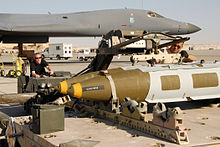
The B-1B underwent a series of flight tests using a 50/50 mix of synthetic and petroleum fuel; on 19 March 2008, a B-1B from Dyess Air Force Base, Texas, became the first US Air Force aircraft to fly at supersonic speed using a synthetic fuel during a flight over Texas and New Mexico. This was conducted as part of an ongoing Air Force testing and certification program to reduce reliance on traditional oil sources.[124] On 4 August 2008, a B-1B flew the first Sniper Advanced Targeting Pod equipped combat sortie where the crew successfully targeted enemy ground forces and dropped a GBU-38 guided bomb in Afghanistan.[94]
In March 2011, B-1Bs from Ellsworth Air Force Base attacked undisclosed targets in Libya as part of Operation Odyssey Dawn.[125] The USAF had 66 B-1Bs in service in September 2012, split between four squadrons organized into two Bomb Wings: the 7th Bomb Wing at Dyess AFB, Texas, and the 28th Bomb Wing at Ellsworth AFB, South Dakota.[101][126]
With upgrades to keep the B-1 viable, the air force may keep the bomber in service until approximately 2038.[127] Despite upgrades, the B-1 has repair and cost issues resulting from its age. For every flight hour it needs 48.4 hours of repair. The fuel, repairs and other needs for a 12-hour mission costs $720,000 as of 2010.[128] The $63,000 cost per flight hour is, however, less than the $72,000 for the B-52 and the $135,000 of the B-2.[129] In June 2010, senior US Air Force officials met to consider retiring the entire fleet to meet budget cuts.[130] It is expected to be supplemented by the Next-Generation Bombers beginning in the 2020s.[131] In the meantime, its "capabilities are particularly well-suited to the vast distances and unique challenges of the Pacific region, and we'll continue to invest in, and rely on, the B-1 in support of the focus on the Pacific" as part of President Obama's "Pivot to East Asia".[132]
In August 2012, the 9th Expeditionary Bomb Squadron returned from a six-month tour in Afghanistan. Their nine B-1Bs flew 770 sorties, the most of any B-1B squadron on a single deployment. The squadron spent 9,500 hours airborne, while having one of its bombers in the air at all times. They accounted for a quarter of the combat aircraft sorties over the country while there and averaged 2–3 requests for air support per day.[133] On 4 September 2013, a B-1B participated in a maritime evaluation exercise, deploying munitions such as laser-guided 500 lb GBU-54 bombs, 500 lb and 2,000 lb Joint Direct Attack Munitions (JDAM), and Long Range Anti-Ship Missiles (LRASM). The aim was to detect and engage several small craft using existing weapons and tactics developed from conventional warfare against ground targets; the B-1 is seen as a useful asset for maritime duties such as patrolling shipping lanes.[134]
Variants
- B-1A
- B-1B
- B-1R
Existing external hardpoints would be modified to allow multiple conventional weapons to be carried, increasing overall loadout. For air-to-air defense, an Active Electronically Scanned Array (AESA) radar would be added and some existing hardpoints modified to carry air-to-air missiles. If needed the B-1R could escape from unfavorable air-to-air encounters with its Mach 2+ speed. Few aircraft are currently capable of sustained speeds over Mach 2.[136]
Operators
Aircraft on display
- B-1A
- 74-0160 - Wings Over the Rockies Museum at the former Lowry Air Force Base in Denver, Colorado.[138]
- 74-0174 - Strategic Air and Space Museum adjacent to Offutt Air Force Base in Ashland, Nebraska. This aircraft has conventional ejection seats and other features used on the B-1B variant.[139]
- B-1B
- 83-0065 Star of Abilene - Dyess Linear Air Park at Dyess Air Force Base in Texas. This was the first aircraft delivered to the U.S. Air Force. Dyess AFB is home to one of two active Air Force B-1B wings.[140]
- 83-0066 Ole Puss - Heritage Park at Mountain Home AFB in Idaho with wheels in the wells.[141]
- 83-0067 Texas Raider - South Dakota Air and Space Museum at Ellsworth Air Force Base in South Dakota. Ellsworth AFB is home to one of two active Air Force B-1B wings.[142]
- 83-0068 Spuds - Reflections of Freedom Air Park at McConnell Air Force Base in Wichita, Kansas, a former Air Force and Air National Guard B-1B base.[143]
- 83-0069 Silent Penetrator - Museum of Aviation at Robins Air Force Base in Warner Robins, Georgia, a former Air National Guard B-1B base. This aircraft was the sixth B-1 produced, and was delivered to the 96th Bomb Wing at Dyess AFB, Texas on 13 March 1986. This aircraft arrived at Robins AFB in September 2002. Robins AFB was previously home to one of two Air National Guard B-1B wings.[144]
- 83-0070 7 Wishes - Hill Aerospace Museum at Hill Air Force Base in Ogden, Utah.[145]
- 83-0071 Spit Fire - near the main gate at Tinker Air Force Base, Oklahoma. This aircraft was one of two that suffered an in-flight engine failure in 1990 that led to grounding of the fleet.[146]
- 84-0051 - National Museum of the United States Air Force at Wright-Patterson AFB near Dayton, Ohio. It is displayed in the Museum's Cold War Gallery, and replaces the B-1A (74-0174) formerly on display.[147]
Accidents and incidents
Ten B-1s have been lost due to accidents. Between 1984 and 2001, 17 crew members and people on board have been killed in B-1 accidents.[148]Crashes
- On 29 August 1984, B-1A (AF Ser. No. 74-0159) stalled and crashed while performing minimum control speed tests at low altitude. The crew used the escape capsule to leave the bomber, but the parachutes deployed improperly, causing the capsule to hit nose down. The impact killed the B-1's pilot, Rockwell test pilot Doug Benefield, and seriously injured two other crew members.[149][150]
- In September 1987, B-1B (s/n 84-0052) from the 96th Bomb Wing, 338th Bomb Squadron, Dyess AFB crashed near La Junta, Colorado while flying on a low-level training route. This was the only B-1B crash to occur with six crew members aboard. The two crew members in jump seats, and one of the four crew members in ejection seats perished. The root cause of the accident was thought to be a bird strike on a wing's leading edge during the low-level flight. The impact was severe enough to sever fuel and hydraulic lines on one side of the aircraft, the other side's engines functioned long enough to allow for ejection. The B-1B fleet was later modified to protect these supply lines.[151]
- In November 1988, B-1B (s/n 85-0063) from the 96th Bomb Wing, 337th Bomb Squadron, Dyess AFB crashed near Tye, Texas after a fire broke out above the left engines. All four crew members successfully ejected from the aircraft.[151]
- In November 1988, B-1B (s/n 85-0076) from the 28th Bomb Wing, 37th Bomb Squadron, Ellsworth AFB crashed short of the runway at Ellsworth AFB during adverse weather. All four crew members ejected successfully.[151]
- In November 1992, B-1B (s/n 86-0106) from the 7th Bomb Wing, 337th Bomb Squadron, Dyess AFB, Texas, flying on a low-level training flight crashed into a mountain near Van Horn, Texas. All four members of the crew were killed, and the cause was attributed to pilot error.[151]
- In September 1997, B-1B (s/n 85-0078) from the 28th Bomb Wing, 37th Bomb Squadron, Ellsworth AFB, South Dakota, flying in the Powder River Military Operating Area crashed 25 miles (40 km) north of Alzada, Montana. All four members of the crew were killed.[151][152] The review board found that the bomber struck the ground while performing a defensive maneuver.[153]
- On 18 February 1998, B-1B (s/n 84-0057) from the 7th Bomb Wing, Dyess AFB, Texas crashed near Marion, Kentucky when a fire detected by a cockpit instrument panel shut down the aircraft's power.[154] All four crew members were able to eject and were rescued safely.[155]
- In December 2001, B-1B (s/n 86-0114) from the 28th Bomb Wing, 37th Bomb Squadron, Ellsworth AFB, South Dakota, was lost over the Indian Ocean. All four crew members successfully ejected and were rescued.[156] The bomber was flying en route to a long-range combat mission over Afghanistan when the crew declared an in-flight emergency. The pilot, Captain William Steele, attributed the crash to "multiple malfunctions" causing the bomber to go "out of control".[148] Because of the water's depth, the structural data collector (SDC) or "Black Box" was not recovered and the cause was not positively determined. The aircraft had recently returned from a routine Phase Inspection, and was on its first combat mission after returning to the island of Diego Garcia in the British Indian Ocean Territory. This was the first B-1B to be lost during combat operations.[148][157]
- On 4 April 2008, B-1B (s/n 86-0116) lost hydraulic power while taxiing, then crashed into a concrete barrier and caught fire at Al Udeid AB, Qatar. The crew safely evacuated the aircraft. The B-1B was carrying multiple bombs at the time, all but two of which detonated during the fire. The aircraft was destroyed.[158]
- On 19 August 2013, B-1B out of Ellsworth Air Force Base, South Dakota crashed in a remote area near Broadus, Montana. All four crew members survived by ejecting before the aircraft crashed.[159] A report found that the crash was due to a mechanical failure leading to a fuel leak and explosions.[160]
Other accidents and notable incidents
- In October 1990, while flying a training route in eastern Colorado, B-1B (s/n 86-0128) from the 384th Bomb Wing, 28th Bomb Squadron, McConnell AFB, experienced an explosion as the engines reached full power without afterburners. Fire on the aircraft's left was spotted. The #1 engine was shut down and its fire extinguisher was activated. The accident investigation determined that the engine had suffered catastrophic failure, engine blades had cut through the engine mounts and the engine became detached from the aircraft.[151]
- In December 1990, B-1B (s/n 83-0071) from the 96th Bomb Wing, 337th Bomb Squadron, Dyess AFB, Texas, experienced a jolt that caused the #3 engine to shut down with its fire extinguisher activating. This event, coupled with the October 1990 engine incident, led to a 50+ day grounding of the B-1Bs not on nuclear alert status. The problem was eventually traced back to problems in the first-stage fan, and all B-1Bs were equipped with modified engines.[151]
- In June 1994, B-1B (s/n 84-0057) from the 7th Bomb Wing, 9th Bomb Squadron, made an emergency divert to Rhein-Main Air Base, Germany due to a wing sweep malfunction. The crew made a high speed landing at Rhein-Main and stopped 100 feet short of the end of the runway. Afterward the overheated brakes led to a fire of the right main landing gear, but was quickly extinguished.[161]
- On 15 September 2005, B-1B (s/n 85-0066) was extensively damaged by fire while landing at Andersen Air Force Base, Guam. The investigation into the incident concluded that leaking hydraulic fluid and sparks from a wheel being gouged caused a fire to start in the aircraft's right main landing gear as it touched down. The resulting fire damaged the B-1's right wing, engine nacelle, airframe and landing gear, leading to an estimated repair cost of more than $32 million.[162]
- On 8 May 2006, B-1B (s/n 86-0132) from the 7th Bomb Wing, 9th Bomb Squadron, Dyess AFB, Texas, landed "gear-up" during recovery from an 11-hour ferry flight to the island of Diego Garcia. A resulting fire was quickly extinguished and the crew escaped through the top hatch with only a minor back injury to the co-pilot. The air force investigation concluded that the crew "forgot to lower the landing gear" based on the following reasons: 1) co-pilot task oversaturation, 2) co-pilot's wanting to complete a long mission, 3) neither pilot completed the landing checklist, 4) co-pilot's belief that the pilot had lowered the landing gear when he had not, 5) pilot had turned over control to the co-pilot on the final approach and the pilot had reported to base that the landing gear was down when it was not - indicator lights showing the landing gear was still up were working and apparently ignored. As a result the B-1B impacted and slid on the runway, which caused approximately $8 million of damage to the aircraft and runway.[163] After repairs, the B-1B returned to service in 2007.[citation needed]
Specifications (B-1B)
| Rockwell B-1A Cutaway | |
- Crew: four (aircraft commander, copilot, offensive systems officer and defensive systems officer)
- Payload: 125,000 lb (56,700 kg) ; internal and external ordnance combined
- Length: 146 ft (44.5 m)
- Wingspan:
- Extended: 137 ft (41.8 m)
- Swept: 79 ft (24 m))
- Height: 34 ft (10.4 m)
- Wing area: 1,950 ft² (181.2 m²)
- Airfoil: NACA69-190-2
- Empty weight: 192,000 lb (87,100 kg)
- Loaded weight: 326,000 lb (148,000 kg)
- Max. takeoff weight: 477,000 lb (216,400 kg)
- Powerplant: 4 × General Electric F101-GE-102 augmented turbofans
- Dry thrust: 14,600 lbf (64.9 kN) each
- Thrust with afterburner: 30,780 lbf (136.92 kN) each
- Fuel capacity, optional: 10,000 U.S. gal (38,000 L) fuel tank for 1–3 internal weapons bays each
- Maximum speed:
- At altitude: Mach 1.25 (721 knots, 830 mph, 1,340 km/h at 50,000 ft/15,000 m altitude)
- At low level: Mach 0.92 (700 mph (1,100 km/h) at 200–500 ft (61–152 m) altitude)
- Range: 6,478 nmi (7,456 mi (11,999 km))
- Combat radius: 2,993 nmi (3,445 mi (5,544 km))
- Service ceiling: 60,000 ft (18,000 m)
- Wing loading: 167 lb/ft² (816 kg/m²)
- Thrust/weight: 0.38
- Hardpoints: six external hardpoints for 50,000 pounds (23,000 kg) of ordnance (use for weapons restricted by arms treaties[94]) and three internal bomb bays for 75,000 pounds (34,000 kg) of ordnance.
- Bombs:
- 84× Mk-82 Air inflatable retarder (AIR) general purpose (GP) bombs[165]
- 81× Mk-82 low drag general purpose (LDGP) bombs[166]
- 84× Mk-62 Quickstrike sea mines[167]
- 24× Mk-84 general purpose bombs
- 24× Mk-65 naval mines[168]
- 30× CBU-87/89/CBU-97 Cluster Bomb Units (CBU)[N 2]
- 30× CBU-103/104/105 Wind Corrected Munitions Dispenser (WCMD) CBUs
- 24× GBU-31 JDAM GPS guided bombs (Mk-84 GP or BLU-109 warhead)[N 3]
- 15× GBU-38 JDAM GPS guided bombs (Mk-82 GP warhead)[N 4]
- 48x GBU-38 JDAM (using rotary launcher mounted multiple ejector racks)[169]
- 48x GBU-54 LaserJDAM (using rotary launcher mounted multiple ejector racks)[169]
- 12× AGM-154 Joint Standoff Weapon (JSOW)
- 96× or 144× GBU-39 Small Diameter Bomb GPS guided bombs[N 5] (not fielded on B-1 yet)
- 24× AGM-158 Joint Air to Surface Standoff Missile (JASSM)
- 24× B61 or B83 nuclear bombs (no longer carried)[168]
- 1× AN/APQ-164 forward-looking offensive passive phased-array radar
- 1× AN/ALQ-161 radar warning and defensive jamming equipment
- 1× AN/ASQ-184 defensive management system
- 1× Lockheed Martin Sniper XR targeting pod (optional)[170][171]
Notable appearances in media
Main article: B-1 Lancer in fiction
See also
- Aircraft of comparable role, configuration and era
- Related lists

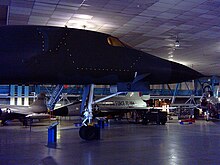



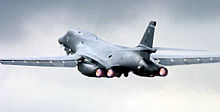
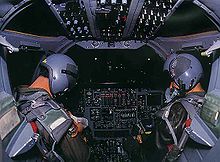


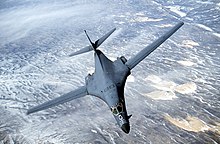


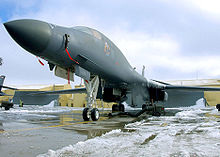

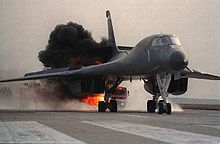



No comments:
Post a Comment